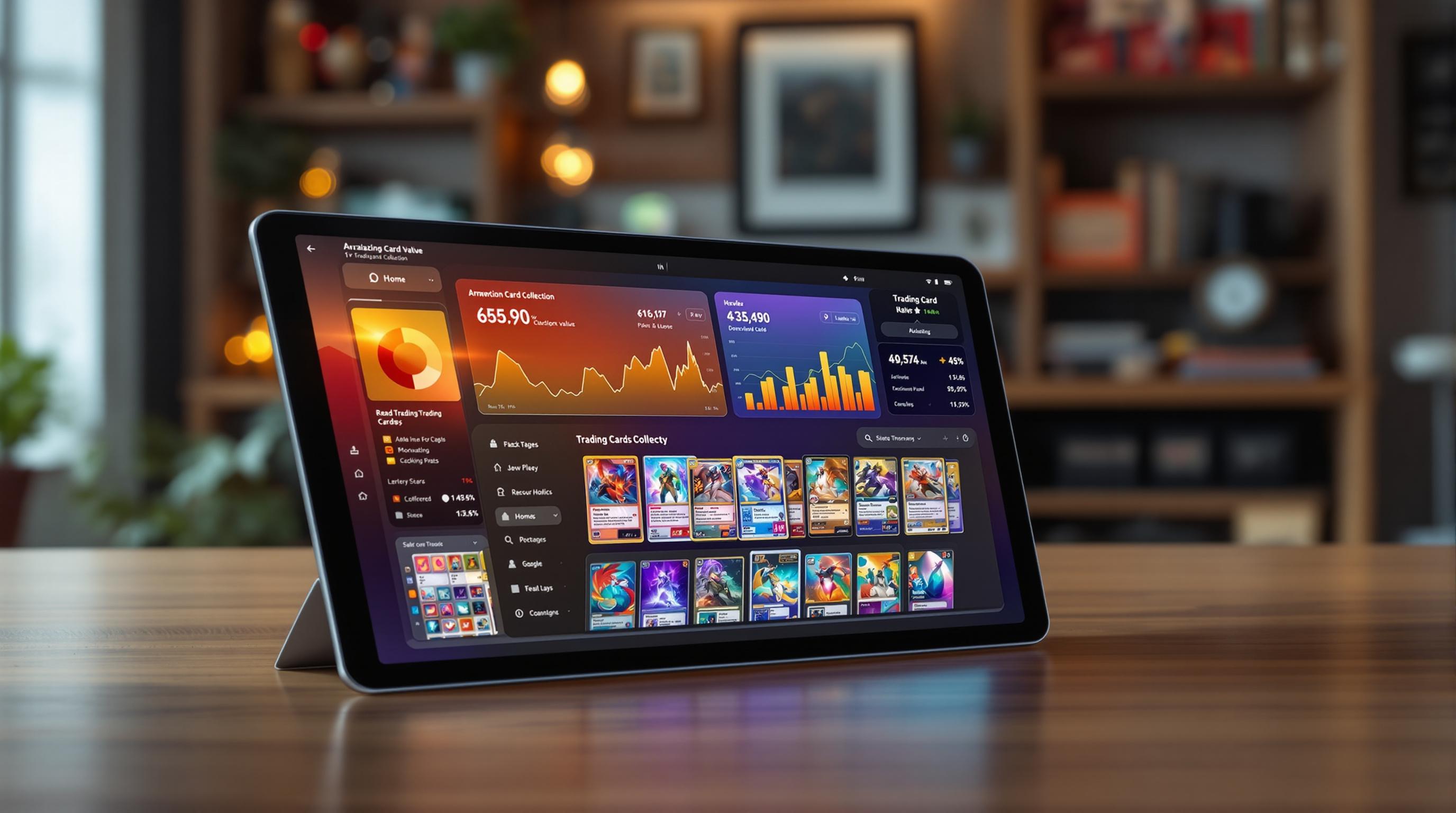Want to know the real value of your trading cards? Historical auction data is the key to understanding market trends and making smart decisions. Here's how you can use it:
- Track Key Metrics: Focus on sale price, transaction date, card condition, grading details, and platform information.
- Find Trusted Sources: Use verified platforms like COMC or local card shops for accurate data.
- Spot Trends: Look for seasonal patterns, price movements, and market activity.
- Compare Prices: Understand the difference between auction values and store prices to time your buys and sells effectively.
Quick Tip: Graded cards often have more stable prices, so always check grading details for better insights. Whether you're a collector or investor, this data can help you buy, sell, or trade with confidence.
How to Analyze Collectible Markets in Real Time Using the ...
What Is Historical Auction Data
Historical auction data captures verified card sales across various platforms and timeframes. It reflects actual market values and trends, helping collectors gauge fair prices in different scenarios. Below, we’ll break down the key metrics and reliable sources that make auction data analysis effective.
Main Data Points to Track
When diving into historical auction data, keep an eye on these critical metrics:
- Sale Price: The final price, including any premiums or fees.
- Transaction Date: The exact date and time of the sale, which can reveal seasonal trends.
- Card Condition: The quality of the card, rated as categories like Near Mint or Excellent.
- Grading Information: Scores assigned by professional grading companies such as PSA or BGS.
- Platform Details: Information about where the sale happened, including its verification status.
Graded cards often provide more consistent and reliable pricing. For example, a PSA 10 Charizard from a specific set typically has steadier price trends compared to ungraded versions.
Choosing Trusted Data Sources
For accurate historical auction data, stick to established platforms with strong verification processes. Look for:
- Verified Records: Transactions backed by proof of payment.
- Professional Marketplace Data: Sales data from recognized trading card marketplaces.
- Authentication Details: Information about card certification and grading.
Using multiple trusted sources ensures a more precise price evaluation. Local card shops can also be a good resource for understanding regional trends and validating online auction data.
A well-maintained sales history allows collectors to:
- Spot market trends.
- Make smarter buying and selling decisions.
- See how card condition affects value.
- Track seasonal price changes.
Where to Find Auction Data
Collectors rely on various platforms to track card values. Here’s a look at some reliable tools and local resources for accessing auction data.
Popular Tools for Tracking Prices
COMC (Check Out My Cards) compiles eBay auction data, offering real-time pricing and trend insights. Collectors can track specific cards, monitor market shifts, and analyze details like condition and grade to make informed decisions.
Leveraging Local Card Shops
Local card shops can be a treasure trove of information and services for collectors. Here's what they often provide:
- Expert Valuation Services: Many shops offer professional evaluations using current market trends and historical auction data.
- Authorized PSA Dealers: Shops like Kenmore Collectibles in North Sarasota can evaluate cards following professional grading standards and historical sales records.
- Consignment Opportunities: Some shops assist with consignment, using auction data to help determine the best pricing strategies.
To make the most of these resources:
- Use the Card Shops List to find stores in your area.
- Reach out to shops directly to learn about their valuation services.
- Ask if they have access to auction data for pricing insights.
- Check if they offer card grading submission services.
These local connections can provide valuable insights into the market and help you stay ahead.
sbb-itb-0db97a5
How to Analyze Auction Data
Verify Card Details
Start by confirming the card's set, year, number, edition, and grading status. For graded cards, make sure to check the certification details to ensure authenticity.
Organize and Compare Sales
- Filter by Condition: Compare items in similar condition to get accurate value insights.
- Set Date Ranges: Focus on recent sales from the past 30-90 days to reflect current market trends.
- Identify Pricing Clusters: Look for consistent price ranges among comparable items.
By organizing sales this way, you can spot recurring trends and better understand market behavior.
Study Price Trends
Sales Volume Insights
- High Volume: Indicates an active market with reliable pricing data.
- Low Volume: May require examining a longer timeframe for accuracy.
- Seasonal Patterns: Watch for recurring price changes tied to specific times of the year.
Price Movement Signals
- Rising Prices: Show consistent growth over time.
- Stable Prices: Stay within a predictable range.
- Falling Prices: Indicate a downward trend that may need closer analysis.
Events like tournaments or new releases can temporarily influence prices, so factor these into your evaluation.
| Price Pattern Type | Timeframe | Key Observations |
|---|---|---|
| Short-term | 30 days | Daily changes and immediate market reactions |
| Medium-term | 90 days | Seasonal effects and event-driven shifts |
| Long-term | 6+ months | Broader market trends and sustained behaviors |
Using Data for Price Decisions
Market Value vs. Store Prices
Knowing the difference between auction prices and retail values can guide smarter trading decisions. Here's a breakdown:
Auction Market Values:
- Represent raw demand in the market
- Tend to fluctuate significantly
- Reflect direct interest from collectors
Store Retail Prices:
- Include service and operational costs
- Offer more stable pricing
- Are typically higher due to added convenience, immediate availability, and in-person evaluations
Understanding these differences becomes even more practical when you tap into local expertise.
Working with Local Shops
Local shops provide more than just a place to buy and sell - they offer valuable insights that go beyond auction data. Using resources like the Card Shops List, you can find stores that offer:
- In-person evaluations and insights into regional market trends
- Professional authentication services to verify item authenticity
- Support for negotiations based on historical data
Bringing auction data to these shops allows for informed, fact-based discussions about pricing.
Market Timing
Once you've compared auction and retail prices, timing becomes a key factor. Seasonal trends and market events can heavily influence prices:
| Season | Market Characteristics | Likely Impact on Prices |
|---|---|---|
| Holiday Season (Nov-Dec) | High demand due to gift-giving | Prices typically increase |
| Spring (Mar-Apr) | New set releases causing market shifts | Prices may fluctuate |
| Summer (Jun-Aug) | Tournament season boosts collector interest | Short-term price spikes |
| Off-season | Fewer transactions, reduced demand | Better opportunities for buyers |
Timing Tips:
- Keep an eye on new set release dates
- Follow tournament schedules closely
- Watch for seasonal buying and selling patterns
- Check market activity levels before making a move
Off-season periods often provide better deals for buyers, while high-demand times like holidays or major gaming events are ideal for selling to maximize profits.
Conclusion
This guide outlines the essential strategies for evaluating the value of trading cards. By analyzing historical auction data, you can more accurately determine a card's worth.
Key actions include verifying card details, checking multiple trusted sources, keeping an eye on seasonal trends, and comparing auction prices with retail values. Local market knowledge can also provide valuable context. Tools like the Card Shops List can help you connect with experienced dealers who provide grading services and understand regional markets.
Since market conditions change frequently, it's important to monitor both historical data and current listings. Whether you're into sports cards, Pokémon, Magic: The Gathering, or other collectibles, balancing online auction insights with local trends will help you make smarter collecting choices.
FAQs
How can I verify the accuracy of historical auction data for card values?
To ensure the historical auction data you use is accurate and reliable, focus on sourcing information from reputable platforms and organizations. Look for data verified by professional grading companies like PSA, Beckett, or SGC, as they assess and authenticate cards based on strict industry standards.
Additionally, cross-check data from multiple trusted sources to spot inconsistencies and get a clearer picture of a card's value over time. This approach helps you make well-informed decisions when evaluating trading cards.
How can local card shops complement online auction data when determining card values?
Using local card shops alongside online auction data offers a well-rounded approach to evaluating card values. Local shops provide opportunities to see cards in person, assess their condition more accurately, and gain insights from experienced collectors or shop owners. These professionals can often share market trends or identify rare cards that may not be as visible in online auctions.
Additionally, local shops sometimes host events like card breaks or trade nights, which can help you gauge current demand and pricing trends within your community. Combining this hands-on experience with the broader data available from online auctions allows for a more informed and balanced understanding of a card’s value.
How do seasonal trends and market events impact trading card prices?
Seasonal trends and major market events can significantly influence trading card prices. For example, the value of sports cards often increases during a sport's active season or leading up to major events like playoffs or championships. Similarly, trading card game (TCG) values may rise when new expansions or sets are released, as collectors and players seek the latest cards.
Additionally, broader market events, such as changes in the economy or shifts in collector demand, can also affect pricing. Cards tied to popular players, characters, or franchises may see spikes during moments of heightened cultural or media attention. Staying informed about these trends can help collectors make smarter buying, selling, or trading decisions.


